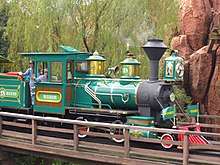Tokyo Disneyland
Tokyo Disneyland (東京ディズニーランド, Tōkyō Dizunīrando) is a 115-acre (47 ha) theme park at the Tokyo Disney Resort in Urayasu, Chiba Prefecture, Japan, near Tokyo.[1] Its main gate is directly adjacent to both Maihama Station and Tokyo Disneyland Station. It was the first Disney park to be built outside the United States, and it opened on 15 April 1983. The park was constructed by WED Enterprises in the same style as Magic Kingdom in Florida and Disneyland in California.[1] It is owned by The Oriental Land Company, which licenses the theme from The Walt Disney Company. Tokyo Disneyland and its companion park, Tokyo DisneySea, are the only Disney parks not wholly or partly owned by the Walt Disney Company (however, Disney has creative control).
.svg.png) | |
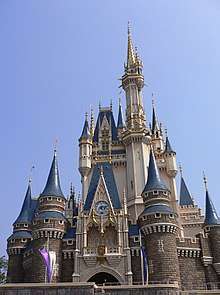 Cinderella Castle is the icon of Tokyo Disneyland. | |
| Location | Tokyo Disney Resort, Urayasu, Chiba Prefecture, Japan |
|---|---|
| Coordinates | 35°37′58″N 139°52′50″E |
| Theme | Fairy tales and Disney characters |
| Operated by | The Oriental Land Company |
| Opened | April 15, 1983 |
| Area | 115 acres (47 ha) |
| Website | Tokyo Disney Resort Homepage |
| Status | Operating |
| Tokyo Disney Resort |
|---|
| Theme parks |
| Resort hotels |
| Shopping, dining and entertainment |
| The Oriental Land Company |
The park has seven themed areas: the World Bazaar; the four traditional Disney lands: Adventureland, Westernland, Fantasyland and Tomorrowland; and two mini-lands: Critter Country and Mickey's Toontown. Many of these areas mirror those in the original Disneyland as they are based on American Disney films and fantasies. Fantasyland includes Peter Pan's Flight, Snow White's Scary Adventures, Dumbo the Flying Elephant, based on Disney films and characters.[2] The park is noted for its extensive open spaces, to accommodate the large crowds that visit the park.[1] In 2018, Tokyo Disneyland hosted 17.9 million visitors, making it the world's third-most visited theme park behind the Magic Kingdom at Walt Disney World Resort and Disneyland Park at the Disneyland Resort.[3]
Dedication
To all of you who come to this happy place, welcome. Here you will discover enchanted lands of Fantasy and Adventure, Yesterday and Tomorrow. May Tokyo Disneyland be an eternal source of joy, laughter, inspiration, and imagination to the people of the world. And may this magical kingdom be an enduring symbol of the spirit of cooperation and friendship between the great nations of Japan and the United States of America.
— E. Cardon Walker, April 15, 1983[4]
History
The initial contract for the construction of Disneyland in Chiba Prefecture was signed in April 1979. Japanese engineers and architects visited California to tour Disneyland and prepare to construct the new park.[5] The construction of the park began a year later and was covered by hundreds of reporters as an indication of the high expectations for the park in the future. The final cost of Tokyo Disneyland was 180 billion yen rather than the projected 100 billion yen.[5]
On 28 February 2020, Disney announced a temporary closure of Tokyo Disneyland and DisneySea from 29 February to combat the COVID-19 pandemic.[6] The closure, originally slated to expire in mid-March, was later extended twice, with the latest extension being until 1 July 2020.[7]
Themed areas
With a few exceptions, Tokyo Disneyland features the same attractions found in Disneyland and Walt Disney World's Magic Kingdom.[1]
- Lands of Tokyo Disneyland
.jpg) World Bazaar
World Bazaar Adventureland
Adventureland
(exterior of Polynesian Terrace Restaurant)- Westernland
(Big Thunder Mountain) .jpg)
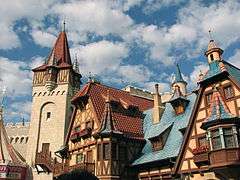 Fantasyland
Fantasyland
(Bavarian theming) Toontown
Toontown
(Gadget's Go Coaster)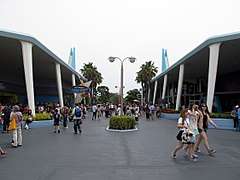
World Bazaar
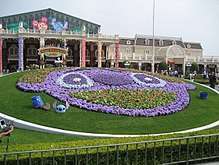
World Bazaar is the main entry corridor and primary shopping area of Tokyo Disneyland. Despite the use of the word "World" in its name, the general look and theme of World Bazaar is that of early 20th-century America, matching the "Main Street, U.S.A." areas of other Magic Kingdom-style parks. World Bazaar consists of two intersecting "streets": Main Street (the primary corridor running from the main entrance toward Cinderella Castle), and Center Street, which forms a perpendicular line with Main Street and leads to Adventureland in one direction and Tomorrowland in the other. World Bazaar has a permanent canopy covering the Main Street and Center Street areas, designed to protect guests from the elements.
Adventureland
Adventureland consists of two distinct yet complementary areas: A New Orleans-themed area and a "jungle"-themed area. It is roughly a combination of the New Orleans Square and Adventureland areas found in Disneyland Park in the United States.
Westernland
Westernland is an "old west" themed area, the counterpart of Frontierland in other Magic Kingdom-style parks. Like its counterparts, the landscape of Westernland is dominated by the Rivers of America, a man-made waterway that is home to the Mark Twain Riverboat, Tom Sawyer Island and numerous live and Audio-Animatronic animals.
Critter Country
Critter Country is a small area of the park and is dominated by a single major attraction, Splash Mountain.
Fantasyland
.jpg)
Like other Magic Kingdom theme parks, Fantasyland's central entryway is a castle, in this case Cinderella Castle, a near exact copy of the one in Florida's Magic Kingdom. Lacking any "thrill rides," Fantasyland's attractions are generally dark rides that take visitors through scenes from Disney films such as Snow White and the Seven Dwarfs, Peter Pan, and Pinocchio.
Toontown
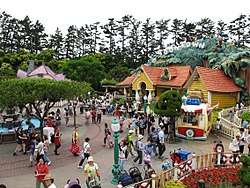
Like its counterparts in other Disney theme parks, Toontown (called "Mickey's Toontown" at other Disney parks) is heavily inspired by the movie Who Framed Roger Rabbit. Appropriately, the major attraction here is Roger Rabbit's Car Toon Spin.
Tomorrowland
As is the case with other modern-day Disney theme parks, Tokyo Disneyland's Tomorrowland forgoes a realism-based vision of the future and instead features science-fiction fantasy themes. Architecturally it borrows much from the 1971–1993 version of Florida's Tomorrowland. Rides include Space Mountain, Star Tours–The Adventures Continue and Buzz Lightyear's Astro Blasters.
Attendance
| 2012 | 2013 | 2014 | 2015 | 2016 | 2017 | 2018 | Worldwide rank |
|---|---|---|---|---|---|---|---|
| 14,847,000[8] | 17,214,000[9] | 17,300,000[10] | 16,600,000[11] | 16,540,000[12] | 16,600,000[13] | 17,907,000[14] | 3 |
Future
Since the park opened in 1983, Tokyo Disney Resort has regularly been one of the most profitable Disney Resorts. By 1994, over 149 million people had entered through the gates of Tokyo Disneyland, more than Japan's entire population of 127.6 million at the time.[15] In 1996, it employed 12,390 people, making Tokyo Disneyland the biggest workplace in Japan’s diversionary outings at that time.[15] Many speculate that Tokyo Disneyland is such an economic success due to timing and location; the theme park lies in a metropolitan area with a population of 30 million and opened at the height of a booming economy where hard-working citizens desired an escape from reality.[16]
Tokyo Disneyland states that one of its main aims is to improve the park and diversify from the limits of the domestic Disney parks. Tokyo Disneyland has recently been adding a national identity within the parks by adding attractions with distinctly Japanese qualities. Cinderella Castle displays the Disney character and story plot yet presents the story through the eyes of the Japanese. Once dominated by Disney Legends, Masatomo Takahashi, the former president of The Oriental Land Company, states this growth and development as one of its primary goals: "We must not just repeat what we receive from Disney. I am convinced that we must contribute to the cultural exchange between Japan and U.S.A."[5]
Incidents
See also
References
- "Japan's Disneyland a little different". Pittsburgh Post-Gazette. 9 October 2011. Archived from the original on 10 January 2012.
- "Attractions – Tokyo Disneyland". Tokyo Disney Resort. Archived from the original on 2013-11-24. Retrieved 2016-10-10.
- "TEA/AECOM 2018 Global Attractions Report" (PDF). Themed Entertainment Association. 2018. Archived from the original (PDF) on 2019-06-06. Retrieved 2019-05-27.
- Spence, Jack (2012-02-20). "Disney Dedication Plaques". Allears. Archived from the original on 8 August 2016. Retrieved 9 July 2016.
- "Oriental Land Co, Ltd. creation period – 50 years of History". OLC Group. 1980-11-28. Archived from the original on 2016-03-04. Retrieved 2016-10-10.
- "Tokyo Disneyland to close through mid-March on coronavirus concerns". CNBC. 2020-02-28. Retrieved 2020-03-12.
- Yasharoff, Hannah. "Tokyo Disneyland, Universal Studios Japan extend park closures over coronavirus". USA TODAY. Retrieved 2020-03-12.
- "TEA/AECOM 2012 Global Attractions Report" (PDF). Themed Entertainment Association. 2012. Archived from the original (PDF) on April 8, 2014. Retrieved July 25, 2013.
- "TEA/AECOM 2013 Global Attractions Report" (PDF). Themed Entertainment Association. 2014. Archived from the original (PDF) on 2014-06-06. Retrieved 2014-06-06.
- "TEA/AECOM 2014 Global Attractions Attendance Report" (PDF). Themed Entertainment Association/AECOM. 2015. p. 7. Retrieved May 27, 2016.
- "TEA/AECOM 2015 Global Attractions Attendance Report Report" (PDF). Themed Entertainment Association. 2016. Archived (PDF) from the original on June 18, 2016. Retrieved June 3, 2016.
- "TEA/AECOM 2016 Theme Index and Museum Index" (PDF). Themed Entertainment Association. 2016. Archived (PDF) from the original on June 2, 2017. Retrieved June 6, 2017.
- "TEA/AECOM 2017 Theme Index and Museum Index" (PDF). Themed Entertainment Association. 2017. Archived (PDF) from the original on May 17, 2018. Retrieved May 17, 2018.
- "TEA/AECOM 2018 Theme Index and Museum Index" (PDF). Themed Entertainment Association. 2018. Archived (PDF) from the original on May 23, 2019. Retrieved May 23, 2019.
- Raz, Aviad E (2000). "Domesticating Disney: Adaption in Tokyo Disneyland". Journal of Popular Culture. 33 (4): 77. doi:10.1111/j.0022-3840.2000.3304_77.x.
- Rishou, Makiya (1994-04-12). "Disneyland in Tokyo Is a 10-Year Hit : Entertainment: The attraction thrives, even during an economic downturn. It has had 140 million visitors". Los Angeles Times. The Associated Press. Archived from the original on 2016-03-07. Retrieved 2016-10-10.
